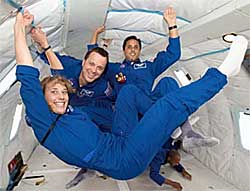Physics of Colonizing Space

Astronauts in zero gravity
Image courtesy of NASA
Our planet has long sheltered humanity from the harsh climates of outer space. The Earth's electromagnetic field protects us from a barrage of harmful particles and its atmosphere allows us to breathe freely while destroying small inbound space rocks.
Though it sometimes seems like a burden, humans have evolved to Earth's gravitational pull, and it is vital to our existence.
Humans have adapted to every climate type and inhospitable badland on this planet. From the arid deserts of the Middle East to the brutal ice wastelands of Antarctica, the discovery of each new frontier has pushed the limits of human survival. But as humans begin to leave the protections of Earth, the physics of life in space will present a whole new set of challenges.
The first space colonists could be NASA astronauts or wealthy private citizens. Either way they will have to overcome challenges that even our most adventurous ancestors never could have imagined.

Astronauts run on weighted treadmills in space.
Image courtesy of NASA
The physics of zero gravity makes everyday tasks like going to the bathroom and eating, complex enough to require intensive training and specialized equipment. Even something as human as motion sickness could be hazardous in a spacesuit (which Army scientists demonstrated in 1996 using Progresso canned vegetable soup as a “vomitus-simulating substance”).
In the early days of the NASA space program, scientists weren't even sure if humans could survive in space at all. No one knew for sure what consequences would arise from life without Earth's gravity or if the human heart could still beat without it.
As author Mary Roach points out in her book Packing For Mars: The Curious Science of Life in the Void, scientists were paranoid that human organs would cease to function in space. The eyeballs might change shape and make work impossible; the heart might not be able to pump blood through the body and muscles might severely cramp up (she also points out the extreme irony of strapping a human to “a carload of explosives” and then worrying about the effects of gravity).
Thanks to a string of unfortunate monkeys all named Albert, we soon learned that the human body could operate fine without gravity. But, in the days since John Glenn's first space flight, we've also learned that life in space isn't without consequence to the human body.

Sam the Space Monkey
Photo courtesy of NASA
Every time you exert your bones and muscles by jogging or carrying something heavy, cells in the body step up to repair and reinforce them. Weightlessness signals to those cells that there's no need to perform their usual duties. In fact, it's been shown that an astronaut spending just two years on Mars would have the same bone strength as a paraplegic. If they returned to Earth, they could break a bone simply walking out of the spacecraft.
A space station could simulate gravity by putting a large circular room into motion and then having the weightless astronaut jog along the walls like Frank Poole in 2001: A Space Odyssey, but no one has ever tried it. Instead, NASA has its astronauts jog while anchored to a treadmill, an exercise that still only simulates 70 percent of the astronauts Earth-weight. On an average six month trip to the International Space Station, an astronaut currently looses about one fifth of their bone mass. Some medical researchers say that this alone could prevent long term space travel.
Hundreds of astronauts have now shown that it is possible to survive the rigors of space in the short term, but colonizing Mars and beyond will require a more permanent form of survival. To live on Mars would require an unrelenting and disciplined exercise routine, and even then, it's uncertain what other long term consequences there might be on the body.
Another effect of living off planet will be long term exposure to things that the Earth would ordinarily protect us from. Any human journeying across the solar system in a spaceship would be bombarded by unfiltered radiation from our sun and dangerous cosmic rays bulleting their way across the galaxy.
One potential way to avoid long term exposure to radiation on the Martian surface would be to take shelter in caves. A team of scientists working under a grant from the NASA Institute for Advanced Concepts thinks that the recent discovery of caves on Mars could provide a solution. The group has experimented with placing mice in a self-contained biosphere that can create its own oxygen using a skylight cave in Oregon thought to be similar to those found on Mars.
Of course, no spacecraft in government or private hands is currently capable of escaping Earth's gravity, though President Obama has made plans to have astronauts on Mars by the mid 2030s.
Arizona State University physicist Paul Davies recently proposed a plan that could have humans living off planet much sooner: a one way trip. He says that eliminating the return leg of the mission could cut as much as 80 percent from the cost. If interplanetary travelers were willing to stay on Mars permanently, it would make the trip possible almost immediately.
The trip wouldn't be a suicide mission, but rather would send healthy and well trained people in their 60s along with enough food and medical supplies to last them a lifetime. Unsurprisingly, Davies says his inbox is already flooded with volunteers.














